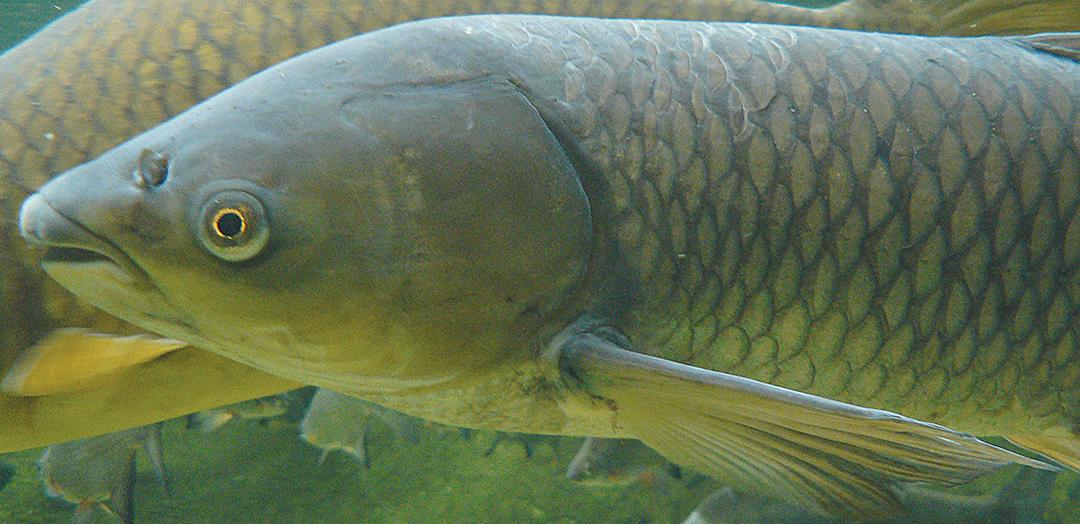
14 minute read
Shooting lessons?
Do I need a shooting instructor?
By LEN PATTON
To the question, “Do I need a shooting instructor?” Todd Bender would say YES!
He should know – he is a world champion skeet shooter and conducts classes and individual lessons all over the country and also has published several CDs about skeet shooting.
Todd, as good as he is, still has a shooting coach. A coach will notice little things that make a difference in winning or losing a match.
He points out that one doesn’t have to be a good shot to be a good teacher. A teacher does have to be able to communicate and diagnose shooting problems.
HOW TO FIND ONE
Here are some suggestions that may be helpful in finding an instructor. First, get some
Todd Bender with legendary Olympics shooter Kim Rhode.
recommendations and then set up a meeting, or at least a telephone conference with that individual.
Tell the coach why you feel professional instruction would be helpful. Perhaps you are seeking help, not for yourself, but for a youngster or a female shooter.
During this conference, it is appropriate for the client to ask the instructor about his or her background, including instructing professionally, and also hunting and shooting.
If the intent is to just learn how to shoot skeet or trap, then fine, but in some cases, learning how to prepare for an upcoming hunting experience is what is needed. Then perhaps another instructor would be better.
Sometime in this conference, the instructor and the student need to discuss the length of time and when and where the instruction would take place. Instructors have to arrange for use of a range and how long they may need to use it.
This is also the time to discuss cost. Instructors will vary as to how much they charge. The student may be expected to furnish his or her own shells and gun and perhaps even pay for range time. Shotgun shooting is not an inexpensive sport.
THE ANSWER
Should I still get shooting instruction? The answer is yes. I mentored with three different instructors for two years before I ever taught a class, and I still seek help from time to time.
I never charge for instruction. This is my way of encouraging people to learn how to shoot and hunt. I must confess that as an instructor, I truly enjoy sharing in the moment when a student breaks his first target or reports the success he has had on his first hunting experience. When this happens, I know I have done my job.
This article is dedicated to my friend, mentor, coach, and teacher Willis Corbet, a member of the American Trap Shooter Association’s Hall of Fame and the Missouri association’s hall of fame as well.

Todd Bender gives a lesson to a young shooter.
Relax!

You’re On Float Time
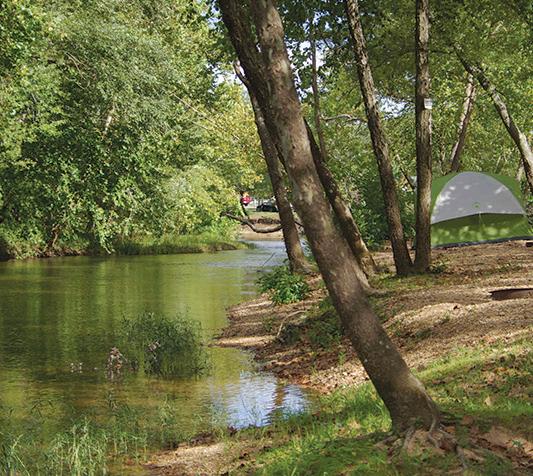
Waynesville, MO • www.rubyslanding.com



Float Trip Destinations
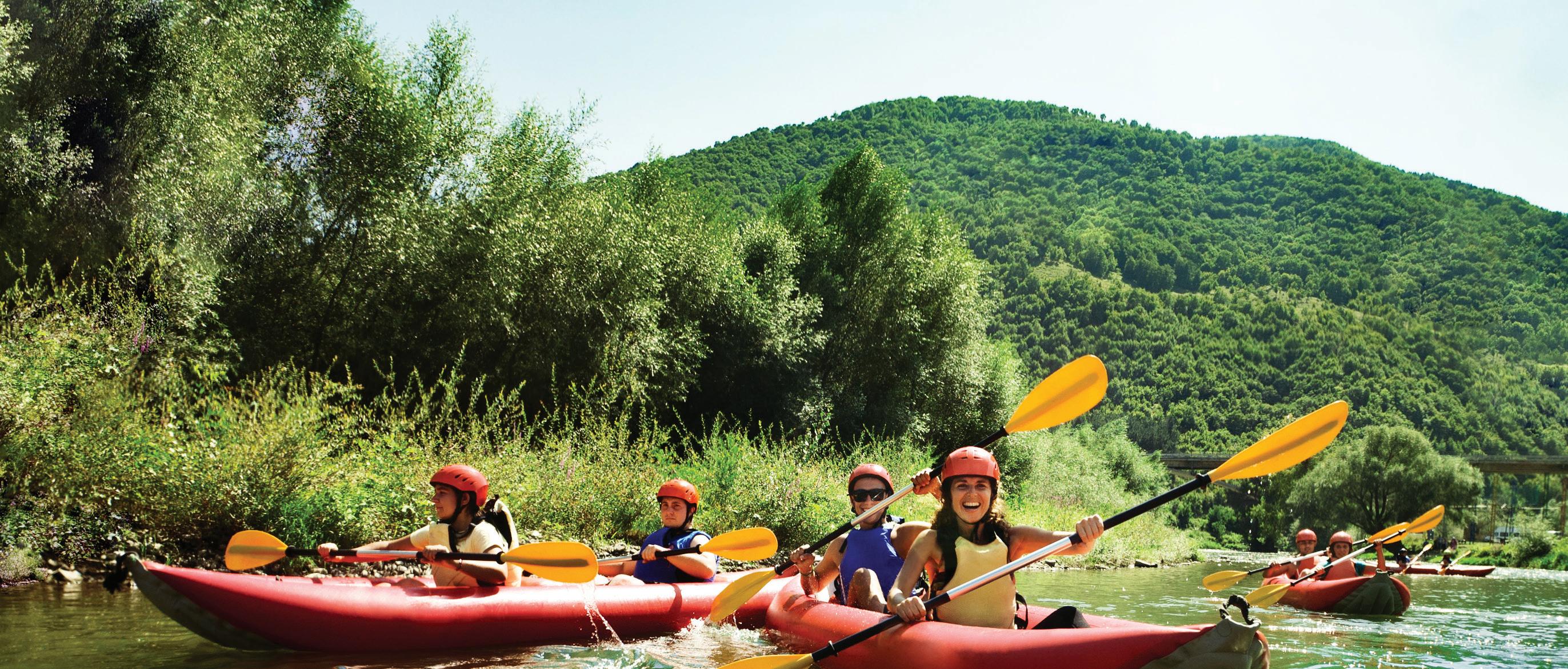
Don’t Miss your opportunity to be a part of the next Float Trip Destinations page. For Information Contact Dan Braun (314) 256-4136 or dbraun@outdoor-guide.com
Only 1-1/2 Hours from St. Louis
• Canoes • Rafts • Kayaks • Tubes • Swimming Pool • Lodging • Group Rates • Catered BBQ’s • Riverfront Camping • Horseback Riding
10% OFF Floating Rates with this ad.
www.bassresort.com • 573.786.8517
bassriverresort@gmail.com
Is your boat surviving winter?
By BOAT US
Boating boomed in 2020, with thousands of first-time boat buyers desiring respite from the pandemic. Now many of these new boat owners are learning how to maintain and store their vessels for the first time.
A mid- or late-winter visit to check on the boat − no matter if stored ashore in a backyard or a marina parking lot − is a wise thing to do. Boat Owners Association of the United States (Boat US) offers these tips to ensure there are no surprises at spring commissioning.
WATER IS BAD
The number one concern for any boat in long-term winter storage is water. It can’t be allowed in, but if it does get in, the water needs a way out.
Check your boat’s winter cover to ensure it still allows rain and heavy snow loads to easily shed away from the boat. Small boats should have the drain plug removed.
A tight-fitting winter cover will also help keep out critters, including raccoons, feral cats and muskrats, whose damage boat insurance policies generally do not cover.
TAKE IT HOME
If you forgot to bring home the life jackets when you put the boat away in the fall, it’s best to do it now.
That includes throwable devices you keep near the helm. They will last longer and stay cleaner. Store them in a dry location at home.
Signal flares can be kept aboard if they are in locations not affected by moisture. Some handheld air horns can leave a not-easy-to-remove rust ring when stored in their upright position.
Both signal devices can be put into zipper-lock freezer bags. Other common items boaters mistakenly leave on their boat during winter storage are liquid cleaners that can burst open during the freeze/thaw cycle and food, which draw vermin.
AIR IT OUT
Try to ventilate the boat, which will help keep mold and mildew at bay. If the boat is closed tightly and doesn’t have ventilation, use desiccants – often sold in bucket-type containers – in
• Ramblings from page 19
scouts had been watching they would have signed me up immediately as I executed a perfect 50-yard field goal, putting one of those buckets up and out of the running pen. The entire battalion of bird dogs visually tracked the bucket as it cleared the pen. Then they snapped their attention back to me, eager to witness my next trick.
THE GLACIER WINS
But the best was when I again challenged the glacier in another part of the kennel and in a flash, performed a couple of high kicks rivaling any New York Rockette.
And again, the glacier won as I found myself in a heap, looking up and admiring just how blue the sky was.
It kind of knocked the breath out of me, and my wife came over, asking if I was all right. I groaned a little, until enough air re-entered my lungs to articulate that nothing was broken.
Finally finishing chores, I hobbled and stumbled to the house. The last I looked, the bird dogs were still in their attentive sitting position, ears perked, waiting for another performance. Sorry to disappoint them.
I’m slowly accepting the fact that winter isn’t like I remember it. There aren’t a lot of rabbits to hunt. They don’t make metal coffee cans anymore. And the ice and snow is so much slicker now.
WHY NOT THE LOTTERY?
I’ve also realized all this vigorous winter activity has settled in my joints. And I can tell every morning, when I can’t even fall out of bed to greet the day, even though falling seems to be a new winter hobby for me.
My wife tells me that this year, we should try to maintain more balance in our lives accepting both trials and triumphs equally.
I just keep hoping to win the lottery. Then let’s see if I slip and fall on some sandy beach closer to the equator. cuddy cabins or living space below.
Follow the manufacturer instructions and you should be able to keep a fairly dry boat over the long winter storage period, making spring cleanup easier and preserving your boat’s value.
BE SAFE
There may be ice and snow this time of year. If you need to use a ladder, make sure it’s firmly planted, always tie it off at the top, and have a friend hold it while you’re ascending or descending.
Never move or adjust a jack stand – call the yard for assistance. Tying off a winter cover to jack stands is also a very bad idea, as the stands can be yanked out from under the boat during high winds.
BoatUS is the nation’s largest organization of recreational boaters with more than 700,000 members, at BoatUS.com.
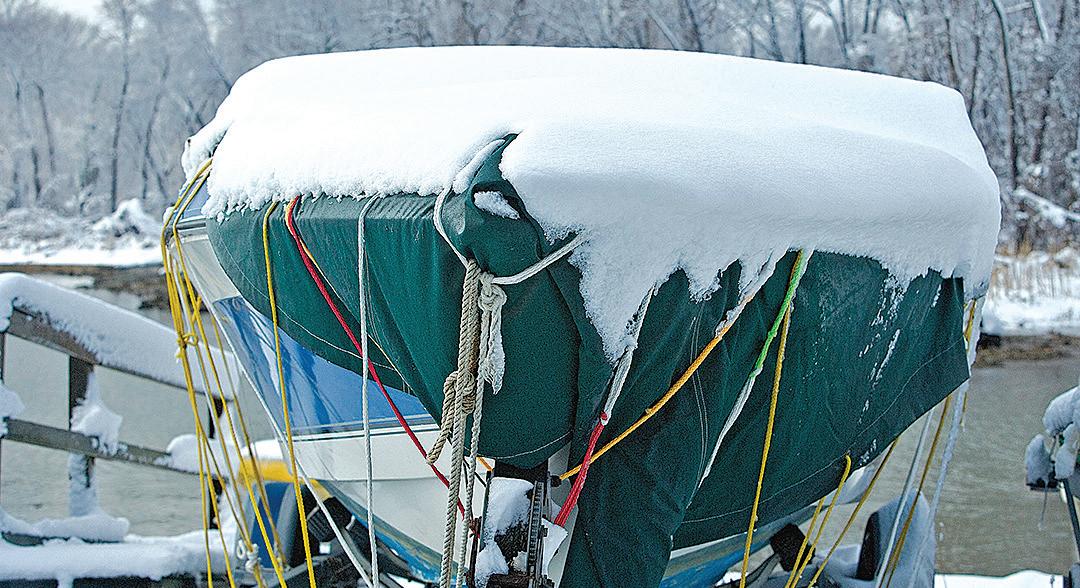
Check that the winter cover is doing its job, unlike this one. – Michel Istaphanous, BoatUS

Early season crappies a lesson in fishing
Photo and Text By DON GASAWAY
Pre-spawn crappies teach us how to fish for all species. They require stealth, patience, ability to read the water, sound knowledge and in general, provide an apprenticeship for all fishing.
The early season crappie angler needs to pinpoint the hideouts and hone tactics to match the fast-changing conditions present.
Crappies feed according to weather and barometric pressure changes.The changes cause fish to move tight to cover and become inactive. The smart angler looks for warmer water. In doing so he can seek out colored water, a windward shoreline, a dark soft bottom, shallow water, tributary streams and heat-absorbing cover such as wood.
Early season crappies are found shallower on dark, warm days and deeper on clearer, colder days. High water is common, and the fish often move up into the temporarily flooded vegetation. Wise anglers check a variety of depth zones and never leave out checking oddball locations.
USING JIGS
Jigs are the most popular crappie lures. They have no action of their own.The angler provides all the action with line movement. To enhance action, use a small sinker and tie it on the end of the line. It will allow the jig to move freely and permit it to rest in a semi-vertical position.
In cold water the color of the jig is not that important. White, yellow and black jigs cover all the bases.Use the smallest jigs you can find.Jigs of 1/16th ounce or smaller are

Early spring crappie anglers can sample all their tackle in search of their go-to choice. It’s time to test those lures they acquired over the winter.
best. Early on it helps to add a minnow to the jig.
For those who want to use plastic lures, a one-inch grub is good. Rig it with the tail down for best action.
As for fishing line, a light, small diameter line is best.You have to be able to feel the tiny bump of a fish or you will miss him. Transparent four-pound test line is best. Good line is small in diameter, strong with little stretch and abrasion resistant.
THREE METHODS
There are three basic methods to catch crappie – vertical jigging, dabbling and casting/ retrieving jigs. • Vertical jigging involves parking the boat over a known crappie location and dropping the jig straight down. • Dabbling requires a long pole to drop the jig into pockets and holes of heavy brush or flooded cover. Use a short section of line, moving the jig from one spot to the next. It is jigged a bit and then pulled up and moved to the next area. • Casting a jig involves casting up the shoreline and then retrieving it with a slow swimming motion.The depth at which the jig runs varies by speeding up and slowing down the retrieve. Once fish are located at a specific depth, the angler concentrates on that depth.
Cold water crappies are not usually aggressive feeding fish.Fish slowly.They will not chase bait very far. You have to put it on their nose. Most of the bites come as the lure is on the rise.
If you fish the zone, stay within five feet of that level, as the fish will concentrate at that depth. You need to keep your jig right among the crappie. You can count down the jig to the desired depth.By counting 1, 2, 3, etc., the jig will fall one foot for each number.
Determine the level of suspended fish. Dropping a jig to the bottom, then cranking or lifting it back up accomplishes the same thing.
THREE KEYS
Crappie feed above their location, as that is how they see. Once you start catching fish on the rise, it tells you just how deep the fish are feeding.
In cold water keep your technique simple. Keep an open mind.
There are three keys to catching cold-water crappie. They are, use the right equipment, fish slowly and keep your lure where the fish are. Not a bad philosophy.
ROUBIDOUX CREEK
Today 1:17 PM “Out all day.
Got a lead on a big one.”

CLEAR YOUR SCHEDULE. GET TO PULASKI COUNTY, MO!
Rare white bison joins Branson herd
Watching the wildlife at Dogwood Canyon Nature Park is a great thing to do anytime, but this spring it has become even more special because of the addition of a rare white bison calf.
Named “Takoda,” a Sioux word meaning “friend to everyone,” the male calf was born on a private ranch and brought to live with the herd of bison currently roaming Dogwood Canyon.
Jeremy Hinkle, director of wildlife there, said a white bison birth is exceptionally rare, with some estimates saying only one in 10 million bison are born white.
But it seems likely now because of conservationists’ efforts to save the bison from extinction. Two centuries ago, more than 30 million American bison roamed the plains, but their numbers plummeted to fewer than 2,000 by the 19th century. Now, with the help of conservationists, about 350,000 bison live in the U.S.
“Though still rare, the phenomenon is more common due to crossbreeding with cattle as a result of attempts by ranchers to save the species from extinction after original populations plummeted to only a few hundred between 1830 and 1900,” Hinkle said. Takoda,
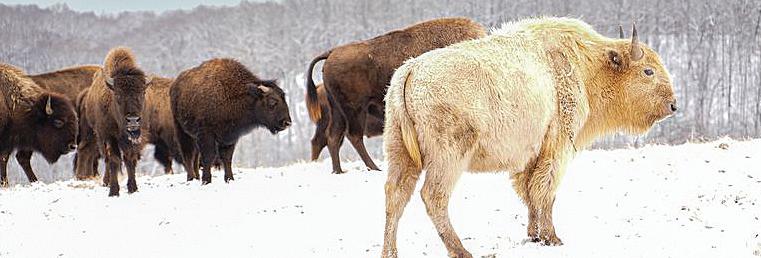
A white bison has been spotted at Dogwood Canyon Nature Park and named Takoda, a Sioux word meaning ‘friend to everyone.’ – Dogwood Canyon photos

he said, shows the delicate balance of conservation that saved this species from near extinction. Takoda also serves as a visual example of the meaning of white buffalo in native cultures, especially Plains tribes.”
A VIVID REMINDER
Bob Ziehmer, senior director of conservation for Bass Pro Shops, which helps operate the park through its own non-profit, said the bison herd reminds us of how the Native Americans revered and relied on them.
“Welcoming a remarkable white bison like this to Dogwood Canyon Nature Park allows us to expand on the important message that Native Americans live out an unwavering conservation ethic,” he said in an interview. “Their wisdom and understanding about the vital balance between land and people inspires our core conservation principles, even today.”
THE GREAT LEGEND
Bison are found in North America and Europe, while their close relations the buffalo are native to south Asia and Africa, and there are differences in humps and horn shapes, too.
As Hinkle reports, “According to traditional Native American teachings spanning thousands of years, the white bison is a sacred animal that promotes prayerful communication between indigenous people and the Great Spirit, while also serving as a sign of peace and good fortune.”
The legend is that long ago, during a great famine, a Lakota chief sent two boys to hunt for food. While searching, they came across a beautiful woman who gave their tribe a white buffalo calf chanupa, or pipe. Before she left, she turned into a white buffalo and told them that when the white buffalo returns, it will be a sign of good fortune and their prayers will be answered.
This must be the time, because in addition to Takoda, white bison have also been spotted in Illinois and Connecticut in recent years. But if you’re feeling inspired to visit these beautiful creatures, make sure you admire them from afar because bison injure more people than any other animal, and they can run three times faster than humans. The National Park Service recommends keeping a 25-yard distance from them.
Now Takoda becomes the highlight of the park’s twohour guided tour, on which you can safely observe the bison and also the elk and deer herds.
HOW TO SEE
THE WHITE BISON
Visitors to the 10,000-acre Dogwood Canyon Nature Park, on Missouri Rte. 86 just west of Branson, can see Takoda and the rest of the bison herd by taking part in a Wildlife Tram Tour ($25 for adults, $15 for children after admission is paid). The two-hour guided ride takes passengers through the canyon and into the ridgetops to see the herds of bison, elk, and deer along the way.
Park hours are 9 a.m. to 4 p.m., Monday through Thursday. Admission is $15, with some activities costing extra. Activities including hiking, trout fishing, horseback riding, Segway tours, wildlife tram tours and bike rentals. For more information, go online to dogwoodcanyon.org.

